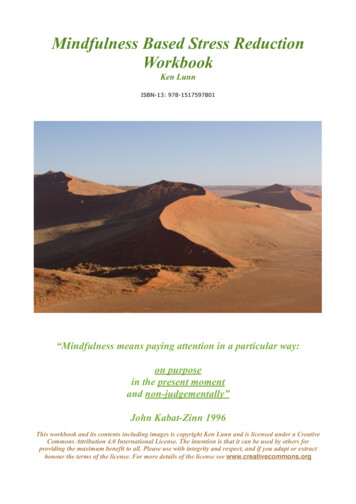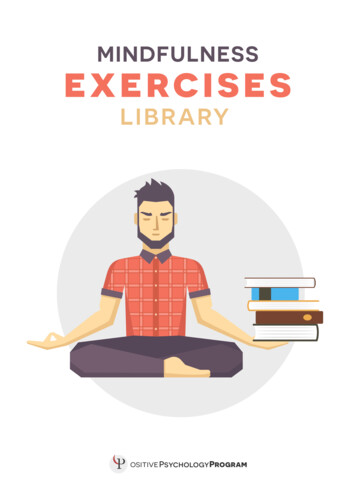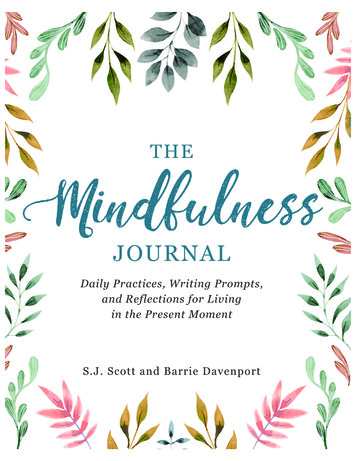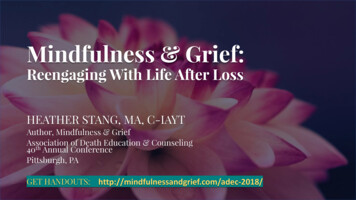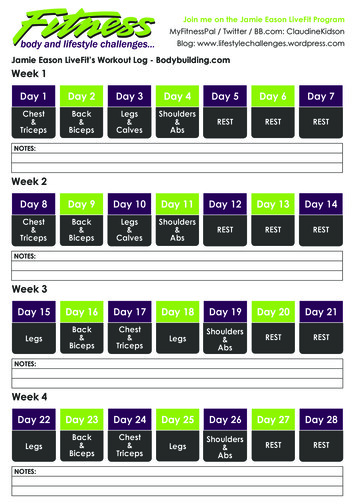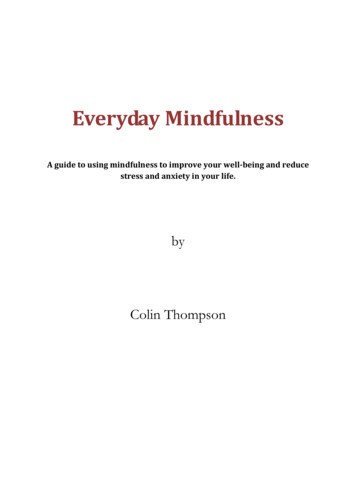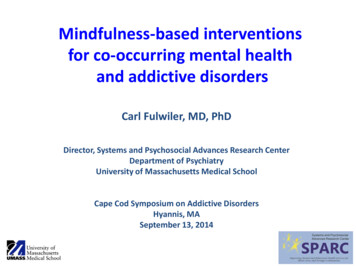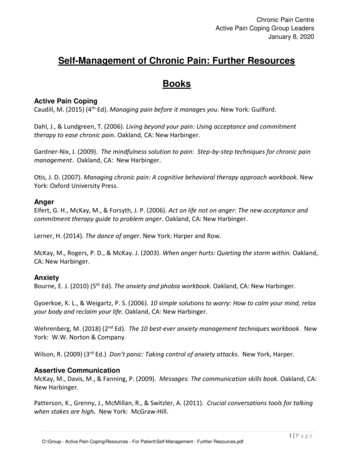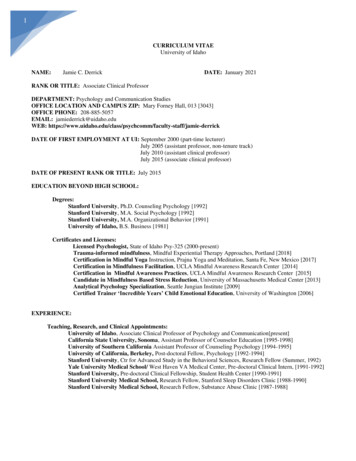
Transcription
Rezvan Ameli, Ph.DLast revised 120420Do not copy or distribute without permissionMindfulness BasicsA Mindfulness Audio ProgramManual for the audio programWhat you need to know to get started on the practice of mindfulnessBy:Rezvan Ameli, Ph.D.This material is intended for use only for the NIH staff and patients. Please do not distributecopies to others.1
Rezvan Ameli, Ph.DLast revised 120420Do not copy or distribute without permissionContentsList of audios and topicsIntroduction to the programHelpful suggestionsDay 1. Introduction to mindfulnessDay 2. The indispensable components of mindfulnessDay 3. Attitudinal foundations of mindfulnessDay 4. Body ScanDay 5. Mindfulness blossomsDay 6. Practice development and common challenges to meditationDay 7. Mindfulness meditation with various anchorsDay 8. Application of mindfulness to walking, eating, and consumptionDay 9. Application of mindfulness to COVID 19 and mindful hand hygieneDay 10. Compassion for health: loving kindness meditationDetailed practice descriptions:Mindful breathingBody scanMindful walkingSound as an anchorMindful seeing and contemplationMindful movementsMindful eating and consumptionMindfulness and COVID: Hand hygieneCompassion for healthLoving Kindness meditationTransforming difficult emotionsTips for daily mindfulness2
Rezvan Ameli, Ph.DLast revised 120420Do not copy or distribute without permissionPause and breatheConcluding poemShort list of resources3
Rezvan Ameli, Ph.DLast revised 120420Do not copy or distribute without permissionIntroduction to the programAttention is a powerful tool. Scientific explorations in the West and old age wisdom traditionsfrom the East tell us that, when we bring the power of our kind and gentle attention toourselves and to our experiences, we engage the natural healing abilities that can serve ourwellbeing on all levels—physical, psychological, and even spiritual.The word mindfulness refers to this kind, tender, and friendly awareness that we can bring tothe present moment experiences. This is known to reduce stress and enhance wellbeing. Whenwe practice mindfulness, we are simultaneously practicing a number of overlapping skills suchas: present moment orientation, non-judgment, letting go, and acceptance. The sciencebehind mindfulness and its health benefits is very strong.The programThe mindfulness program we are offering you is designed to help cultivate and strengthen yourinnate ability to be mindful. It consists of 10 audio recordings from 10-25 minutes. These audiorecordings focus on learning and practicing mindfulness basics. We ask that you listen at leastonce to each recording per day for 10 days during the program. Allow sufficient time to startand to end your practice so you do not feel rushed while listening to the recordings. One of thefruits of mindfulness is cultivating calmness and stillness.Mindfulness is a very simple practice. What might make it challenging is the persistence and thepatience that is needed for regular practice. Often, we schedule our activities based on whatfeels urgent and important. But they are two different dimensions. Naturally, what feelsurgent and important goes on the top of the list (e.g. an acute health issue). What is not urgentand not important goes to the bottom of the list (e.g. a TV program that is not too interesting).The question of prioritization become a bit more complicated when we try to choose betweennot urgent but important versus urgent but not really important, especially if you step back andthink about it. We sometimes buy into a false sense of urgency.Your self-care practices may not feel urgent, but they are important. Think about the timeswhen you postponed important self-care practices in favor of what might have felt urgent atthe moment but was not really important. By their nature, mindfulness and meditativepractices will not feel urgent. It, therefore, requires additional attention and commitment tomake it a regular part of your day.The program is educational in nature. It can be helpful in reducing stress. It can also be ahelpful adjunct but not a substitute for medical, psychological, or psychiatric treatments. Pleaseconsult your healthcare provider if you have any concerns.4
Rezvan Ameli, Ph.DLast revised 120420Do not copy or distribute without permissionThe program and audio recordings are designed by Dr. Ameli and are informed by her 18 yearsof teaching, reading and writing, practicing, and researching mindfulness with the purpose oftransforming your relationship to stress and to assist you to enhance self-care.The teacherDr. Ameli is an accomplished clinical psychologist, researcher, author, and teacher. She hasbeen studying, practicing, and teaching mindfulness for well over 18 years. She has worked atthe National Institutes of Health in several capacities for over 20 years. She has held academicpositions at Yale University and University of Connecticut prior to her NIH career. She receivedthe NIMH Director’s award in 2009 in recognition of her “extraordinary commitment topromoting employee health and productivity by stress reduction through mindfulness.”Dr. Ameli was invited by the American Psychological Association (APA) in 2010 to write a bookon the subject of mindfulness which was published in 2013. Her book received the BenjaminFranklin Award in body, mind, and spirit category in 2014. She is a frequent lecturer onmindfulness locally and nationally. Her book has been translated to several languages. One ofher mindfulness programs, developed for healthcare workers at the NIH has been published inthe Journal of American Medical Association (JAMA Network Open, Ameli et al 2020).Please Note the FollowingRegular time & suitable place: If possible, choose a regular time during the day to practice.Also choose a place in which you feel safe, distraction free, and comfortable. You can make thisyour special place with a few cherished items. A place where you can take a deep breath,exhale, and say “Yes I am here.” That said, you can practice anytime, anywhere as long as youfeel comfortable.Clothing: Wear comfortable clothing for added ease. Taking off shoes and removing glassescan also add to your comfort.Yoga mat/blanket: It is recommended that the Body Scan (Day 4), to be performed in the lyingdown position, on a blanket/yoga mat if possible. If not possible, it could also be practiced inthe sitting position. We will practice the Body Scan in a seated position on Day 5.Meditation Cushion: Some prefer practicing on a meditation cushion when practicing mindfulbreathing. If you are not used to meditation cushions, it is better to sit on a chair for sittingpractices.No pagers-cell phones: You owe it to yourself to carve out and keep your practice timedistraction-free. Please turn off your cell phones or pagers or other sources of news andcommunication to the extent that is safe for you and your family. Focused attention is anecessary element of mindfulness practice.Practice Journal: Journaling about your practice can enhance your efforts.5
Rezvan Ameli, Ph.DLast revised 120420Do not copy or distribute without permissionDay oneIntroduction to mindfulnessThe first audio introduces you to the concept of mindfulness followed by a short practice.Below are several definitions of mindfulness and related information that we hope will enhanceyour understanding of mindfulness and its practice.Definitions of MindfulnessMindfulness is to be aware It is to be in touch with your felt experience in each moment ”"Mindfulness is to know when you are breathing in and to know when you are breathing out.""Mindfulness is the capacity to be aware of what is here. Anything can be the object ofmindfulness. Your breath. The sky ”-Thich Nhat HanhBook recommendations:Peace is Every StepTrue LoveBe Free Where You AreBeing Peace“Mindfulness is paying attention, on purpose, in the present moment, and non-judgmentally, tothe unfolding of experience moment by moment.”-Jon Kabat-Zinn, Ph.D.Book recommendation: Full Catastrophe Living“Mindfulness is to distinguish awareness from mental activity, it is to learn to be aware of ourown mental states without being caught in them.”-Jack KornfieldBook recommendation: Wise Heart6
Rezvan Ameli, Ph.DLast revised 120420Do not copy or distribute without permissionAudio #1 TranscriptMy name is Rezvan Ameli and I will be your mindfulness guide. On behalf of myself and ourresearch team at the National Institutes of Health, also known as the NIH, I want to thank youfor your participation. After a few introductory comments I will introduce you to mindfulnessand then we will have a short practice.I am a clinical psychologist and have been at the NIH for over 20 years working as a clinician,researcher, writer, and teacher. One of the areas of my great interest in the past 2 decades hasbeen mindfulness. Mindfulness is known to reduce anxiety and stress, improve coping, andenhance resilience, wellbeing, and quality of life. I became interested in mindfulness when Iwas going through a very stressful and painful time in my life and since then I have seen itsbenefits in mine and many other lives.You might have had other experiences with meditation and mindfulness and may even haveestablished practices. Please know these and other life experiences will only enrich yourcurrent experience with the teachings we will be offering you. Please bring the beginner’smind to the teachings that will follow. Engage in them as if for the first time and with a freshmind.I am delighted to share my experiences with mindfulness and guide your experience in the next10 days through the audio recordings that you will receive each day. Please give yourself thegift of your time and attention to the mindfulness practices that we have lovingly andattentively recorded for you.I believe these short lessons are efficient and effective. There is, however, a caveat. Strivings,expectations, and judgments are some of the most powerful sources of stress and I hope thatour lessons will strengthen your ability to let go of attachment to the results and expectations,including expectations from these lessons. I invite you to a space of acceptance, ease, andpresence during our lessons together.So, what is mindfulness? Mindfulness is an umbrella term for several formal and many informalpractices. Formal practice can include a regular practice of, for example, mindful breathing,mindful walking or body scan. The audio recordings that are offered can indeed establish aformal practice of mindfulness for you in the next 10 days. Informal practices are theapplication of mindfulness principles to various activities and experiences throughout the day.At their core, these practices are all about relating to our experiences with moment to momentattention and awareness. To be present to and stay with your experiences as they unfold: ifyou are showering just shower, if you are eating just eat, if you are cutting vegetables just dothat, and if you are guided to focus on the breath stay with the breath. Mindfulness changesour relationship with stress by helping us choose our response rather than automatically reactto stressful situations out of habit.7
Rezvan Ameli, Ph.DLast revised 120420Do not copy or distribute without permissionOne of the simplest definitions of mindfulness is to be aware and in touch with our feltexperiences in each moment. In addition to the intention to be mindful, and turning ourattention and awareness to our experiences, the invitation is to come to the table ofmindfulness with a special attitude, a certain attitude, and that is an attitude of non-judgment,friendliness, openness, acceptance, and even tenderness.We keep the mind engaged in what is happening right now and when the mind wanders away,we gently redirect the mind back to the present moment experience while maintaining afriendly, non-judgmental, open and accepting attitude.Let’s do a short practice right now. I sound a soft bell to start and to finish the practice. Listento the sound to the end with focused attention.Our practice will be in a sitting position. So if you have not been sitting, take a moment to find aseat and make yourself comfortable. You may even stop this audio for a moment and restart itwhen you are in a comfortable position.8
Rezvan Ameli, Ph.DLast revised 120420Do not copy or distribute without permissionDay TwoThe indispensable elements of mindfulness Intention. Mindfulness is a conscious choice. Setting our intention to be mindful isnecessary for establishing a regular practice. Attention & Attitude are the two wings of mindfulness. Focused attention and atender, positive, loving attitude. A sharpshooter has focused attention. Is s/hemindful? Typically not. The attitude with which we focus our attention is anecessary component of mindfulness, the invitation is to engage a kind, tender,gentle, accepting, non-judgmental, and friendly attitude. A compassionate one.This is what compassionate attitude looks like! Awareness is the ability to witness our experience without being caught in theexperience. The ability to observe ourselves. The ability to observe the breath, a sound,a thought, a memory without losing the quality of a witness.9
Rezvan Ameli, Ph.DLast revised 120420Do not copy or distribute without permissionAudio #2 TranscriptWelcome to our second practice.Today I’d like to bring your attention to 4 elements or aspects of mindfulness that I find to beindispensable. And then we will do a mindful breathing practice incorporating sounds.First, I’d like to introduce you to two definitions of mindfulness which capture these 4elements. One definition is by Dr. Kabat-Zinn and the other by Dr. Kornfield. References totheir work are listed in the manual.Jon Kabat Zinn, a biologist from Harvard, was instrumental in bringing mindfulness to the foldsof Western medicine. His definition of mindfulness is quite popular. He defines mindfulness aspaying attention, on purpose, in the present moment, and non-judgmentally to the unfolding ofexperience moment by moment.Jack Kornfield is a well-known American teacher of Buddhism. He says “Mindfulness is todistinguish awareness from mental activity. It is to be aware of our own mental states withoutbeing caught in them.”These 2 definitions highlight four aspects of mindfulness that I believe to be important indeveloping our practice of mindfulness.The first aspect or element is intention. Mindfulness is a purposeful act. It is a choice. Evenafter years of practice, mindfulness remains a choice. Intention helps us persist with practicedevelopment. Whenever you find yourself wavering about practicing mindfulness regularly,check back with your intention to practice. You may develop an intention to practice towelcome a sense of well-being (without striving), or to stay mindful and nonjudgmental, to bepresent to your experiences, to cultivate peace or joy, any mindful intention will serve you. Youcan also develop an intention for each individual practice. Stating these seemingly simpleintentions to yourself with commitment and purpose, can be powerful engines for continuedand regular practice.The second element of mindfulness is focused attention and refocusing the attention when itwanders away. Typically we choose an anchor to focus and refocus the attention. Similar to theanchor of a boat which prevents the boat from drifting too far, an anchor of attention helpssteady the mind. Various meditative traditions use different anchors. For example, inTranscendental meditation a Mantra, which is repeating a word or a sound is used toconcentrate the attention. Some other forms of meditation may use a visual anchor such as animage, a color, or light of a candle. Still, others may use a place on the body such as the spacebetween the eyebrows, or the upper lip as the anchor of attention. In mindfulness meditationthe anchor of attention can be anything. Any activity. The most popular ones are the breath,10
Rezvan Ameli, Ph.DLast revised 120420Do not copy or distribute without permissionwalking, and bodily sensations. We will practice and introduce you to several anchors ofattention during the course of these audio recordings.The third element of mindfulness is the attitude with which we concentrate the attention.What arises in the field of consciousness can be pleasant, unpleasant, or neutral. Regardless ofthese qualities of experience, the invitation is to maintain an attitude of non-judgment andremain accepting, friendly, and open to the experiences that unfold. This can be challengingespecially if the experience is unpleasant in nature. What is important to remember is thatavoidance of experience does not work. Even if there is pain, avoiding pain increases tensionand does not produce relief. What is already here in the mind or body cannot be avoided.Mindfulness invites us to allow what is already here to be here without avoidance. Byaccepting and making room for the experience psychologically, we create a breathing spacearound the experience which then can diminish the unpleasantness. It is like dissolving aspoonful of salt in a bucket instead of a glass of water! We lighten up the experience.Especially in reference to unpleasant states, understandably, it is difficult to make room forthem. And, the good news is that with practice we can. We all have the capacity to be mindfulof our experiences and enhance them with practice.The fourth element of mindfulness is the ability to witness our experiences rather thanbecoming one with them. It is to observe our thoughts, sensations, and emotions withoutgetting caught or lost in their story. It is to cultivate the ability to observe our thoughts,emotions, and sensations as events in the field of consciousness – observe them as they arise,linger, and pass and then another one arrives and then another .Labeling is a helpful way ofincreasing our ability to witness our experiences without entanglement. In our practice today Iwill incorporate labeling and you can see if that helped with your ability to observe and witnessexperiences. It is important to understand that “not getting caught” is not the same as disassociating from our experiences, pushing them away, or suppressing them. Far from it.Observing and witnessing experiences is about acknowledging their presence, letting them be,standing side-by-side with them, and then to also letting them go. It is to stay even with ourdifficult experiences without reactivity and or attachment.Now we will turn to our practice for today.I will sound a soft bell to start and to finish the practice.Our practice will be in a sitting position. So if you have not been sitting, take a moment to find aseat and make yourself comfortable.11
Rezvan Ameli, Ph.DLast revised 120420Do not copy or distribute without permissionDay ThreeAttitudinal foundations of mindfulnessAudio #3 TranscriptSeveral attitudinal orientations are known to enhance mindfulness. The relationshipbetween these qualities and mindfulness is reciprocal. They strengthen each other.When we practice mindfulness we are simultaneously strengthening nonjudgment,patience, beginner’s mind, trust, non-striving, acceptance and letting go. Dr. Kabat Zinnhas recently added 2 more qualities to these 7 attitudes, that is, generosity andgratitude. He has a 26-minute YouTube video-recording on these 9 attitudes ofmindfulness that I highly recommend. We have touched on several of these attitudes inour previous 2 lessons.1. Non-Judgment Mindfulness is cultivated by assuming the stance of an impartial witness to yourown experience. Even when you notice the mind has become judgmental, observing andbecoming aware of judgments is the mindful approach. The task is not to stopjudgments the task is to become aware, let go, and direct the attention back tothe anchor. We must also distinguish between discernment and judgment. Discernmenthelp us to see what is and establish proper boundaries, whereas judgmentobscures our vision and feeds into a biased view of ourselves, others and theworld.2. Patience Patience is necessary for development of mindfulness. A child may try to help a butterfly emerge by breaking open a chrysalis butchances are the butterfly won’t benefit from this help. Practicing patience reminds us not rush through some moments of our lives inorder to get to other ‘better’ ones – each moment not valued is a moment notfully lived.3. Beginner’s Mind Is the willingness to see everything as if it is for the first time. It is the recognitionthat each moment is unique and contains unique possibilities. Too often we let our thinking and our beliefs about what we ‘know’ stop us fromseeing things as they really are. This will prevent us from being receptive to newpossibilities we get stuck in our own “expertise.” Try it with familiar experiences/people. Next time you see someone you know,try to see them with fresh eyes, as they are in the moment you see them. Try itwith problems with nature with the dog with the food.12
Rezvan Ameli, Ph.DLast revised 120420Do not copy or distribute without permission4. Trust Is to believe in yourself, your feelings, your own authority and intuition. It is tosit with your own experience and observe what is really here even if you maymake mistakes along the way. It is trusting in your sense experiences. It is notabout being reckless or impulsive. It is not an invitation to act.5. Non-Striving Is to back off from expecting or seeking specific results. To accept things as they are. With patience and regular practice, movement towards wellbeing occursnaturally.6. Acceptance Acceptance is about making room for what is already here--- pleasant, unpleasant,or neutral. We often waste a lot of time and energy denying what is here when wedo not have a choice. We do not have a choice about our human condition whichincludes sickness, pain, and death. What we have a choice about is how we relateto these experiences. We always do our best to take good care of ourselves. Forexample, if we have a headache, resisting the headache is not useful. Accepting theheadache is here does not mean we will not seek remedy. Pain is pain and is aninevitable sensation. Pain plus resistance creates unnecessary friction and suffering.Acceptance helps to take the suffering out of the equation. It helps make room forthe experience, whatever it is, so we can choose our response rather than react outof habit.7. Letting Go Is about cultivating an attitude of non-attachment. Each time we exhale we areletting go of our breath. Each time we take a step we are letting go of our stability. If we find it particularly difficult to let go of something because it has such a stronghold on our mind, we can direct our attention to what ‘holding’ feels like. Holding onis the opposite of letting go. Letting go is to accept the truth of impermanence. Nothing is permanent. It is toaccept not to hold on to what we cannot hold on to. Lama Suraya Das asks, “howcan we respond to loss, failure, illness, death, tragedies, calamities, injustice,betrayal, shock, trauma, abuse, grief, and life’s most hurtful wounds?” and adds,“Attachment is like holding on tightly to something that is always slipping throughour fingers--it just gives us rope burn. “ Letting go of what does not serve us can be practiced at different levels. We canstart with letting go of the objects we no longer need, actually start with one drawerand let go what is not needed!8. Gratitude13
Rezvan Ameli, Ph.DLast revised 120420Do not copy or distribute without permission Is about being thankful for what we have and not to take for granted.9. Generosity Is about giving of ourselves to bring joy to others.YouTube Recommendation “Attitudinal foundations of mindfulness” by Jon Kabat-Zinn. 26minutes. The video is very well done. It is done in 2016 and he adds gratitude and generosity tothe attitudinal foundations of mindfulness.https://www.youtube.com/watch?v 2n7FOBFMvXg“When the attitudinal foundations of mindfulness are brought back to their core, two basicprinciples remain, to notice and to bring in a positive outlook to every experience. To exercisegentleness, friendliness and gratitude towards all experience, even difficult ones, as theyunfold, moment to moment under the gaze of your full attention. The gentle consciousnessthat is aware of the experience, even tense or not so gentle experiences, without being caughtin them or losing the texture of gentleness.”-Rezvan Ameli, 201014
Rezvan Ameli, Ph.DLast revised 120420Do not copy or distribute without permissionDay FourBody ScanAudio #4 TranscriptWelcome to the fourth lesson. Today we will be focusing on the practice of body scan and willincorporate mindfulness principles in this practice.The recommendation is to do this first practice of body scan on the floor, lying down on a mator blanket without a pillow if possible. So if you need to stop the audio for a moment andprepare for this practice please do so.The purpose of body scan is to become aware of the sensations in different areas of the body.Very often we ignore our bodies. We spend a lot of time in our heads and not enough time inour bodies. Sometimes we only become aware of a body part when it hurts and the intensityof the discomfort brings our attention to it. Regular practice of body scan helps us stay in closertouch with our body and what is happening in the body. In this practice we explore variousregions of the body. We employ curiosity and the beginner’s mind. We befriend the entirebody and we bring our even-handed attention to all parts and pay attention to all sensationsfrom very subtle or may be even imperceptible all the way to gross sensations. Sometimespeople feel relaxed or even feel drowsy or dreamy when practicing body scan. That can be anadded bonus but it is not the goal of this practice. The idea is not to manipulate yourexperience yet it is preferable to cultivate awareness during the practice. During this practiceyou do not need to change anything no need to manipulate your experience nowhere togo nothing to do.similar to other mindfulness practices, body scan too is a practice ofbeing not doing.Now we turn to the practice of body scan. Allowing enough time to experience this practicewithout feeling rushed.As usual I will announce the beginning and the end with the sound of the bell.15
Rezvan Ameli, Ph.DLast revised 120420Do not copy or distribute without permissionDay FiveMindfulness BlossomsThe Science Behind Mindfulness is StrongSource: Pub med –Articles published on mindfulness in peer reviewed journals 1982-201916
Rezvan Ameli, Ph.DLast revised 120420Do not copy or distribute without permissionMindfulness Helps Reduce Stress By: Present moment orientation. Letting go of thoughts and judgments. Relinquishing attachment to outcomes, expectations, and strivings. Recognition that much of the stress comes from the inside and our own choices, notfrom the outside. Respond rather than react. Decrease negative and increase positive emotions.17
Rezvan Ameli, Ph.DLast revised 120420Do not copy or distribute without permissionAudio #5 TranscriptWelcome to Audio number 5. Today I tell you a little about why mindfulness has become sopopular and its mechanisms of action. We then will practice mindful breathing andincorporate the body scan in a seated position.Mindfulness and mindfulness research have become extremely popular in the last 2 decades. Ibelieve there are several reasons. The capacity for mindfulness is almost universal, it iseffective, it is flexible, it is inexpensive and safe, it does not require adherence to a particularreligion or belief system, and it is strongly supported by research. There has also been asynergy between the presence of spiritual figures such as the Dalia Lama, Thich Nhat Hanh,popularity of mindfulness teachers, and scientists and neuroscientists such as Jon Kabat Zinn,and Richard Davidson. In your manual you will see a graph of the growth of mindfulnessresearch that is reported from PubMed.In terms of the mechanism of action, scientists believe mindfulness regulates attention,regulates emotions, and also enhances the so called “meta cognition” which is the ability toappraise reality impartially. Do you remember the 4 elements of mindfulness we discussed inthe second lesson? These regulatory functions of mindfulness make a lot of sense when weconsider the 4 elements of intention, attention, compassion, and the ability to observe andwitness the experience rather than becoming one with it.This latter point is especially important since it is this ability to become aware to witness andobserve our experience that allows us to change our relationship with stress. Hans Selye whois known as the father of stress research says, “It’s not stress that kills us, it is our reaction it.”And, Victor Frankl a renowned neurologist and psychiatrist says “between stimulus andresponse there is a space. In that space is our power to choose our response. In our responselies our growth and our freedom”.And this is where a technique like mindfulness can be so helpful. The more aware we becomeof what is happening in our minds, hearts, and bodies the better we become able to witnessand observe, and the better choices we make in our responses. We choose our response ratherthan react out of habit. Stress is a part of life. We cannot change that as humans we willexperience stress. What we can change is how we respond.Now we are going to turn to our practice.18
Rezvan Ameli, Ph.DLast revised 120420Do not copy or distribute without permissionDay SixPractice development and hindrances to meditationAudio #6 TranscriptPractice DevelopmentDeveloping a regular practice can be challenging. You need to maintain strong intention andconsider your practice an important and health promoting part of your day, a necessity thatdoes not take the back seat during your busy days. From experience
Jon Kabat-Zinn, Ph.D. Book recommendation: Full Catastrophe Living “Mindfulness is to distinguish awareness from mental activity, it is to learn to be aware of our . mindfulness with a special attitude, a certain attitude, and that is an attitude of non-judgment,
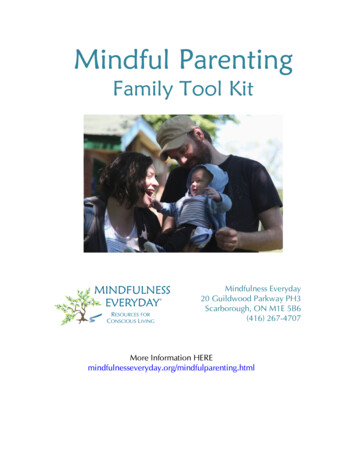
![Welcome [dashdiet.me]](/img/17/30-day-weight-loss-journal.jpg)
